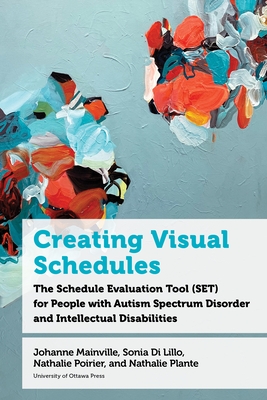图书简介
The SET is a time structure assessment tool that measures the pictorial schedule needed by individuals with Autism Spectrum Disorder (ASD) or Intellectual Disabilities (ID). These individuals typically have deficits in executive function and memory, and therefore have difficulty orienting themselves in time. The goal of the SET is to help caregivers and professionals working with these individuals to determine the type of schedule best suited to their needs and abilities and to implement it in their living environment, thereby promoting their autonomy and, consequently, their quality of life. The SET includes materials, protocols and a manual that allow practitioners and professionals to assess the schedule of children, adolescents and adults in various settings such as educational daycare, school, internship or employment and residential settings. The SET is divided into four distinct parts. The first part involves the manipulation of objects, photographs, pictograms and words in a formal assessment context. The second and third parts take place directly in the setting where the schedule is to be implemented. The fourth part is administered in the form of an interview with the person who knows the person best in the context where the schedule will be introduced. Available formats: hardcover, trade paperback, accessible PDF, and accessible ePub
TABLE OF CONTENTS Preface Acknowledgements List of Figures List of Excerpts Description of Supplementary Material PRESENTATION The Importance of a Schedule The SET’s Overall Objectives Target Population Educator Training INTRODUCTION The Eight Schedule Characteristics Evaluated Using the SET Schedule Evaluation Sequence Required Material Overview of the Schedule Evaluation Protocol Symbol Meaning Information on the Visual Supports Used During the Evaluation PART 1 Goal Duration Administration Sequence 1. Prepare Evaluation Materials for Part 1 2. Identify Where to Start the Evaluation 3. Use the Stop Standards to Identify What Section or Subsection to Evaluate Next 4. Demonstrations, Evaluation, and Scoring 4.1 Detailed Procedure for 1A Subsections 4.2 Detailed Procedure for 1B Subsections 4.3 Detailed Procedure for 1C Subsections 5. Scoring Part 1 in the Schedule Evaluation Protocol PART 2 Goal Duration Administration Sequence 1. Fill in the Required Information in the Schedule Evaluation Protocol 2. Choose the Visual Support Category to Evaluate 3. Determine Where the Mailing Boxes Will Be Installed 4. Prepare the Material for Part 2 5. Prepare the Material Required for the Visual Support Form to Evaluate 6. Demonstrations, Evaluation, and Scoring 6.1 Detailed Procedure for Visual Support Form 1 6.2 Detailed Procedure for Visual Support Form 2 6.3 Detailed Procedure for Visual Support Form 3 7. Scoring Part 2 of the Evaluation in the Schedule Evaluation Protocol PART 3 Goal Duration Administration Sequence for Section 3A 1. Material Preparation for the Evaluation of Section 3A 1.1. For a Visual Support in OBJ Form 1.2 For Other Visual Support Forms 2. Demonstrations, Evaluation, and Scoring 2.1 Detailed Procedure for Subsection 3A.1 2.2. Detailed Procedure for Subsection 3A.2 2.3 Detailed Procedure for Subsection 3A.3 Sequence for Section 3B 1. Identify the Visual Support Form, the Category, and the Type of Schedule Being Evaluated 2. Preparation of Materials Required to Evaluate Section 3B 3. Demonstrations, Evaluation, and Scoring 3.1 Detailed Procedure for Subsection 3B.1 3.2 Detailed Procedure for Subsection 3B.2 4. Scoring Part 3 in the Evaluation Protocol PART 4 Goal Duration Administration Sequence 1. Detailed Procedure for Section 4A: Identifying the Schedule with a Cue that Relates to the User’s Interests 2. Detailed Procedure for Section 4B: Finding an Individualized Location 3. Detailed Procedure for Section 4C: Schedule Content (Activities and Representative Visual Supports) RECOMMENDATIONS REPORT Schedule Characteristics Schedule Content Procedures to Follow Comments and Signature SCHEDULE ADJUSTMENT Use the Adjustment Protocol to Modify these Seven Characteristics Schedule Adjustment Sequence Material Required for the Adjustment Administration Part 1 A. Identify if the Adjustment’s Prerequisites Are Met B. Evaluate the Level of Autonomy for the Current Schedule C. Identify the Characteristics to Adjust Part 2 Adjustment Prerequisites Adjustment Benefits Pre-Evaluation Introduction and Evaluation Phases Recommendations Report PRE-EXPERIMENTAL RESULTS BIBLIOGRAPHY
Trade Policy 买家须知
- 关于产品:
- ● 正版保障:本网站隶属于中国国际图书贸易集团公司,确保所有图书都是100%正版。
- ● 环保纸张:进口图书大多使用的都是环保轻型张,颜色偏黄,重量比较轻。
- ● 毛边版:即书翻页的地方,故意做成了参差不齐的样子,一般为精装版,更具收藏价值。
关于退换货:- 由于预订产品的特殊性,采购订单正式发订后,买方不得无故取消全部或部分产品的订购。
- 由于进口图书的特殊性,发生以下情况的,请直接拒收货物,由快递返回:
- ● 外包装破损/发错货/少发货/图书外观破损/图书配件不全(例如:光盘等)
并请在工作日通过电话400-008-1110联系我们。
- 签收后,如发生以下情况,请在签收后的5个工作日内联系客服办理退换货:
- ● 缺页/错页/错印/脱线
关于发货时间:- 一般情况下:
- ●【现货】 下单后48小时内由北京(库房)发出快递。
- ●【预订】【预售】下单后国外发货,到货时间预计5-8周左右,店铺默认中通快递,如需顺丰快递邮费到付。
- ● 需要开具发票的客户,发货时间可能在上述基础上再延后1-2个工作日(紧急发票需求,请联系010-68433105/3213);
- ● 如遇其他特殊原因,对发货时间有影响的,我们会第一时间在网站公告,敬请留意。
关于到货时间:- 由于进口图书入境入库后,都是委托第三方快递发货,所以我们只能保证在规定时间内发出,但无法为您保证确切的到货时间。
- ● 主要城市一般2-4天
- ● 偏远地区一般4-7天
关于接听咨询电话的时间:- 010-68433105/3213正常接听咨询电话的时间为:周一至周五上午8:30~下午5:00,周六、日及法定节假日休息,将无法接听来电,敬请谅解。
- 其它时间您也可以通过邮件联系我们:customer@readgo.cn,工作日会优先处理。
关于快递:- ● 已付款订单:主要由中通、宅急送负责派送,订单进度查询请拨打010-68433105/3213。
本书暂无推荐
本书暂无推荐












